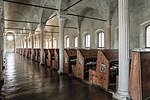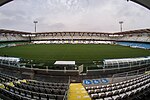Cesena railway station
Buildings and structures in CesenaCesenaRailway stations in Emilia-RomagnaRailway stations in Italy opened in 1861

Cesena railway station (Italian: Stazione di Cesena) serves the city and comune of Cesena, in the region of Emilia-Romagna, northern Italy. Opened in 1861, it forms part of the Bologna–Ancona railway. The station is managed by Rete Ferroviaria Italiana (RFI), while the commercial area of the passenger building is managed by Centostazioni and train services are operated by Trenitalia. Each of these companies is a subsidiary of Ferrovie dello Stato (FS), Italy's state-owned rail company.
Excerpt from the Wikipedia article Cesena railway station (License: CC BY-SA 3.0, Authors, Images).Cesena railway station
Piazza Giorgio Sanguinetti, Unione dei comuni Valle del Savio
Geographical coordinates (GPS) Address Nearby Places Show on map
Geographical coordinates (GPS)
| Latitude | Longitude |
|---|---|
| N 44.145277777778 ° | E 12.249166666667 ° |
Address
Piazza Giorgio Sanguinetti 130
47521 Unione dei comuni Valle del Savio, Quartiere Centro Urbano
Emilia-Romagna, Italy
Open on Google Maps










